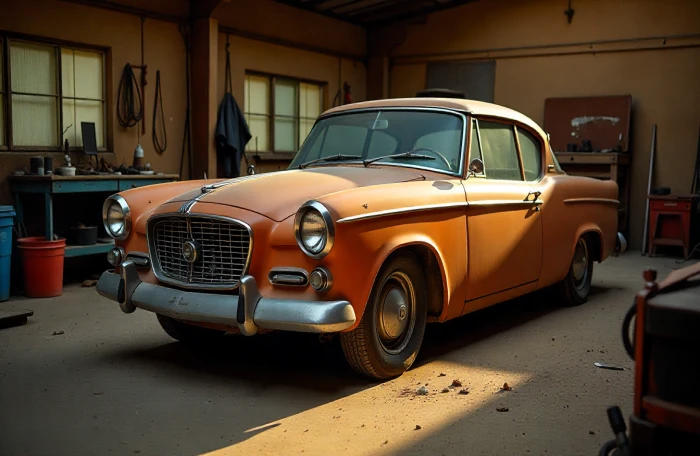1960s Studebaker cars are vintage beauty, which is exactly what they represent. If you’ve ever seen one proudly displayed at a car show or in a neighbor’s garage, you know it looks like nothing else from its time.
Back when Ford and GM were pumping out new cars with big budgets, Studebaker was doing something different. With so little money and limited numbers, the company took bold risks. It made stylish, smart vehicles that stood out, because they had to. That’s why Studebaker’s story is still talked about today.
You may have heard about the Studebaker Lark or seen a sleek two-door hardtop with bucket seats and a wide, low dash. Maybe your grandfather drove one. Or maybe you’re a collector today, hunting for the right model year Lark VI, or a four-door station wagon with original disc brakes and automatic transmission.
No matter what brings you here, you’re going to learn why these cars, especially the 1960s Studebaker lineup, still draw attention. From bold styling to innovative engineering at the South Bend plant, this story is about more than just cars. It's about how a smaller company fought hard to do things their own way, and left behind some of the most memorable body styles in American car history.
What You’ll Learn
How Studebaker started and what made their 1960s vehicles so different
The standout Studebaker models people still want today
What happened to Studebaker, and why it shut down
Overview
The 1960s Studebaker cars are remembered for their unique styling and innovative features, often setting them apart from other American automobiles of the era; the specific interest in these vehicles can vary, ranging from historical significance to collector value and design appreciation.
Here's a more detailed breakdown:
Key Studebaker Models of the 1960s
These are specific car models that represent Studebaker's offerings during the decade, each with distinct characteristics.
1960 Studebaker Lark: A compact car credited with reviving the Studebaker brand, offering various body styles and engine options to appeal to a wide range of buyers.
Studebaker Wagonaire (1963–1966): A station wagon notable for its unique sliding roof, providing versatility for carrying tall cargo.
Studebaker Gran Turismo Hawk (1962–1964): A two-door hardtop featuring stylish design elements and optional performance upgrades, targeting a sport-luxury market.
1963–1964 Studebaker Avanti: An innovative, fiberglass-bodied car known for its futuristic design and record-setting performance, pushing the boundaries of what Studebaker offered.
Distinctive Features of 1960s Studebakers
These are elements that made Studebaker cars unique in the market, contributing to their appeal and historical significance.
Brooks Stevens' Styling: The designer's approach to updating models using existing parts, creating fresh looks without high development costs.
Innovative Engineering: Studebaker's introduction of features like front disc brakes and the Wagonaire's sliding roof, setting them apart from competitors.
Independence from Major Automakers: Studebaker's operations as a smaller, independent company, affecting its design choices and business strategies.
Other Notable Aspects
Studebaker's Decline: Understanding the factors that led to the company's closure, including sales drops and financial challenges, is crucial to understanding its history.
Collector Interest: The ongoing value and appreciation of these cars among collectors, often driven by their rarity and unique designs.
The Rise of Studebaker: How a Wagon Maker Became a Car Pioneer
The Studebaker Corporation started in the early 1850s, building wagons for farmers, miners, and the U.S. military. Studebaker didn’t begin making cars until the early 1900s, starting with electric models followed by gas-powered ones. By the 1950s, the company had already built a strong name for itself. But the 1960s Studebaker cars are where things got interesting.
By the time the new decade rolled in, Studebaker was working hard to stay in the game. The company wasn’t as large as Ford or GM, but that didn’t stop them. The team focused on making compact, affordable, stylish vehicles that stood out.
One of their smartest moves was the launch of the Studebaker Lark in 1959. It helped the company bounce back after slow sales. The Lark was smaller than most other new cars at the time, but it came with smart features and clever styling. Buyers could get a two-door, a four-door sedan, a convertible, or even a station wagon. It was the right car at the right time and it gave Studebaker a fresh start.
The South Bend plant in Indiana was where most of these models were built. The factory worked hard to keep up with demand, even as other carmakers started copying the compact design. At the same time, Studebaker pushed design limits. Studebaker hired Brooks Stevens, a well-known designer, to refresh their cars each year. With limited resources, Stevens got creative. He made smart updates using existing parts; this helped the company avoid high costs while still offering fresh styling.
Through these changes, Studebaker stayed alive while others doubted them. The Lark brought in new buyers. The South Bend plant kept turning out vehicles. And the company proved that good design and smart choices could go a long way, even without a big budget.
Standout Models of the 1960s: The Golden Lineup
The 1960s weren’t easy for Studebaker, but the models they built still stand out. With smart design and strong features, these cars hold a special place among collectors today. Here are the Studebaker models that defined the decade with specs that made them different from the rest.
1960 Studebaker Lark
The 1960 Studebaker Lark saved the brand when bigger American cars were falling out of favor. It was compact, stylish, and packed with options.
Key Specs:
Available body styles: two-door sedan, four-door sedan, convertible, station wagon
Engine: 170 cu in. inline-6 (Lark VI) or 259 cu in. V8
Horsepower: 90–180 hp, depending on engine
Transmission: 3-speed manual or automatic transmission
Brakes: Available disc brakes
Interior: Optional bucket seats, air conditioning
Design: Compact size, wide body, strong fenders
Why it mattered:
With so little money, Studebaker kept things simple but smart. The Lark had great styling, came in many body styles, and sold well across the country.
Studebaker Wagonaire (1963–1966)
One of Studebaker’s most creative ideas was the Wagonaire, a four-door station wagon with a sliding roof.
Key Specs:
Unique roof design: Sliding rear panel to carry tall cargo
Rear doors: Full-size entry for back seat access
Spare tire: Rear-mounted for more cargo space
Engine: Inline-6 or V8 options
Transmission: Manual or automatic
Production: Built in limited numbers
Why it mattered:
No other car maker was offering this kind of flexibility in a station wagon. It was bold, useful, and is now a favorite among Studebaker collectors.
Studebaker Gran Turismo Hawk (1962–1964)
Designed by Brooks Stevens, this two-door hardtop combined old parts with a new look.
Key Specs:
Engine: 289 cu in. V8, up to 240 hp with optional supercharger
Transmission: 3-speed manual or automatic transmission
Styling: Long hood, wide stance, chrome grille
Interior: Bucket seats, luxurious interiors, wood-tone dash
Suspension: Sport-tuned for better handling
Sales: Popular in limited numbers
Why it mattered:
It was Studebaker’s version of a muscle-luxury mix. Strong styling and solid performance made it stand out.
1963–1964 Studebaker Avanti
This was the company’s moonshot—a sleek, fiberglass two-door hardtop that looked like nothing else.
Key Specs:
Body: Lightweight fiberglass shell
Engine: 289 cu in. V8 (up to 290 hp with supercharger by Paxton Products)
Brakes: First U.S. production car with front disc brakes
Transmission: 4-speed manual or automatic
Interior: Full bucket seats, padded dash, premium materials
Features: Power windows, tilt steering, and air conditioning
Top speed: 168.24 mph (Bonneville Salt Flats, 1963)
Design: Created by Raymond Loewy team; futuristic and low-slung
Why it mattered:
The Avanti broke records, impressed critics, and showed what Studebaker could do, if only the factory could build it fast enough.
Other Models: Daytona, Cruiser, Transtar
While the Avanti and Hawk stole headlines, other model years offered solid value and design updates.
Key Highlights:
Studebaker Daytona: Sporty trim line on Lark; V8 power and bucket seats
Cruiser: Upscale four-door sedan with premium trim and ride comfort
Transtar truck: Light-duty truck built alongside cars at the South Bend plant
Why they mattered:
These vehicles gave customers more choice, performance, comfort, or work-ready options, while keeping the brand’s creative edge.
What Made Studebaker Unique? Innovation, Design, and Independence
Studebaker didn’t copy other carmakers. It built its own way forward, even when money was tight. That’s what made its 1960s cars vintage beauties worth remembering. While other brands played it safe, Studebaker took risks that shaped how American cars could look and feel. Here’s what made these cars different:
1. Smart Styling from Brooks Stevens
Brooks Stevens was a designer hired to refresh Studebaker models without building from scratch. With little budget, he used existing parts to create new body shapes and trims.
The Gran Turismo Hawk was built on an older frame but looked brand-new
The Lark got yearly updates to compete with other new cars
Annual changes gave buyers something fresh without breaking the bank
Stevens’ work gave Studebaker a signature style: sleek, sharp, and unlike anything else on the market.
2. Innovation That Pushed Boundaries
While bigger brands waited to add new features, Studebaker tried them first. Some of their bold ideas included:
First U.S. car to offer front disc brakes on the Avanti
Rear-sliding roof on the Wagonaire, perfect for hauling large items
Optional bucket seats, air conditioning, and power features
Wide range of transmission options: 3-speed, overdrive, and automatic
These weren’t gimmicks. These were useful upgrades that made Studebaker vehicles feel modern without the big-brand price tag.
3. Independence from the Big Three
Unlike Ford, GM, or Chrysler, the Studebaker Corporation didn’t have unlimited funding or multiple brands under one roof. Every decision mattered.
Factory workers and designers often wore many hats.
Most production happened at the South Bend plant, keeping things local.
The company used a small number of platforms to build many models.
This lean structure helped Studebaker move fast and think differently, traits that still earn it respect from collectors today.
The Fall: What Went Wrong with Studebaker?
For all its smart ideas, Studebaker couldn’t keep up forever. By the mid-1960s, the company was running out of time and money. Here’s how it all went wrong:
1. Sales Dropped Too Fast
After the strong start of the Studebaker Lark, demand slowed. Other automakers began making their own compact cars. With more choices in the market, Studebaker’s edge faded.
Lark sales dropped year after year after 1960
Models like the Cruiser and Daytona didn’t bring enough buyers
Even the Avanti, sold in limited numbers, couldn’t change the outcome
The company needed a big win. It didn’t get one.
2. Too Many Problems, Too Little Cash
Studebaker had great designers and smart engineers, but not enough money to grow. The company tried to cut costs in ways that hurt it long-term.
It closed some factory operations to stay afloat
Dealers lost faith, and fewer vehicles were sold
Tooling and parts were reused, limiting fresh designs
This wasn’t about bad cars. It was about trying to stay alive with too few resources.
3. Shutdown of the South Bend Plant
The South Bend plant, where most of the best-known 1960s Studebaker cars were built, shut down in December 1963. That was the beginning of the end.
U.S. production stopped
A few models were made in Canada until 1966
After that, the company left the car business for good
The decline wasn’t quick, but it was definitive. Even though many Studebaker models were still solid, the brand couldn’t survive the pressure from larger rivals.
4. A Short Life, But a Lasting Impact
Many of the final cars were still built with care. Some had automatic transmission, bucket seats, and smooth styling. But in the end, it wasn’t enough.
Studebaker’s story is a reminder of how smart ideas and hard work don’t always win when big companies control the game. Still, their cars live on—and so does the name.
Final Thoughts
Studebaker’s 1960s lineup was daring. In an era dominated by massive automakers, Studebaker carved out its legacy with bold design, clever engineering, and a relentless independent spirit. From the practical Lark to the futuristic Avanti, these cars proved that innovation doesn’t always require deep pockets, just vision and grit. Though the company didn’t survive the decade, its cars remain beloved symbols of creativity, resilience, and a uniquely American drive to stand apart.
Transport Your Studebaker the Right Way with AmeriFreight Auto Transport
Moving a classic like a 1960 Studebaker isn’t something you leave to chance. Whether it’s a restored Studebaker Lark, a rare Wagonaire, or a sleek Avanti, these cars need safe transport and expert handling.
AmeriFreight helps owners transport classic cars across the country with options like enclosed trailers and top-load placement. Learn more about protecting long-term value, transport tips for classic cars, or why top-load transport is safer for your vintage beauty.
Frequently Asked Questions (FAQs)
How much is a 1960 Studebaker worth?
A 1960 Studebaker in good condition typically sells for $8,000 to $20,000 depending on model and trim.What was the most popular Studebaker?
The Studebaker Lark was the most popular model of the 1960s due to its compact size and strong sales.What was the downfall of Studebaker?
Studebaker’s downfall came from declining sales, rising costs, and its inability to compete with larger automakers.- What is a 1962 Studebaker Lark worth?
A 1962 Studebaker Lark usually sells for $6,000 to $18,000 based on condition, engine, and originality.















